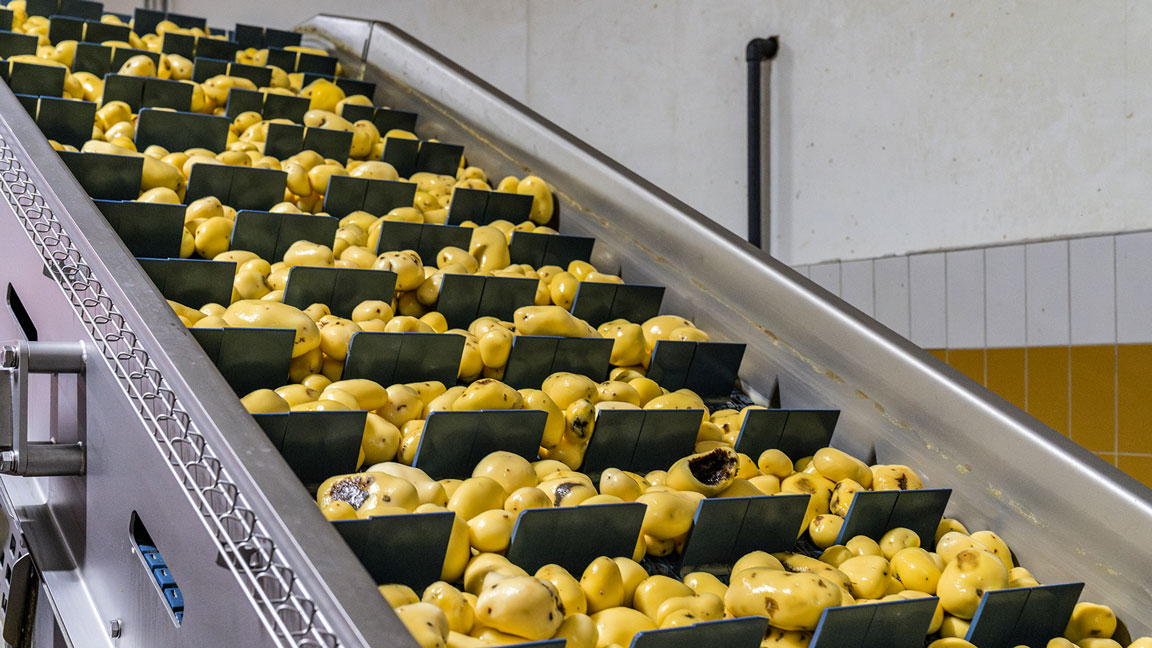
TL;DR: Raw material input variability, driven by climate change and supply chain fragmentation, is the fundamental challenge in modern food manufacturing, causing up to 20% food loss and severe margin erosion. Traditional static control (fixed recipes and PLCs) cannot adapt quickly enough, leaving plants perpetually behind. The solution is Dynamic Process Control (DPC); it involves implementing AI-driven machine vision and sensor data to continuously sense, learn, and automatically adjust process parameters in real-time. This adaptive approach ensures stable quality and maximizes yield, turning process control into true process intelligence.
The fundamental challenge in food manufacturing is simple: no two raw materials are exactly alike. Individual items like potatoes, peas, vegetables, and sugar can differ significantly (not just in size or color, but also in skin thickness, moisture content, or starch levels). This inherent variety makes it increasingly difficult for food manufacturers to maintain stability in their output quality, especially while under pressure from numerous stakeholders. Understanding and managing this input variability is what will distinguish which food processors become champions in their field.
The specifications of resources are crucial for a food processor to set up their manufacturing process. Think of the size of tubers, color variations and defect occurrences on a carrot, or the fat content of chocolate. Since food manufacturers work with organic products, these resources inherently display a large variety in these specifications. It makes it impossible to handle every input batch the same way, a reality very different from that faced by automotive manufacturers, for example. In an ideal world, process parameters should be adjusted continuously to compensate for input changes. In practice, this is often deemed infeasible, resulting in non-conforming products and a significant loss in process yield. As food systems face new pressures, this variability is only intensifying.
This has long been a challenge, but the speed and magnitude of change is something we've never seen before.
The cost of input variability might be hiding in plain sight, but it's far from negligible. It nibbles away at profit margins every day. In fact, Eurostat estimated that up to 20% of food losses occur at a food manufacturing plant. These losses stem from:
Waste occurs in all steps of processing. Now, consider a large potato processing plant producing tens of thousands of tons per year. Even a 1% loss in yield translates into hundreds of tons of lost products, costing hundreds of thousands of euros per year. Beyond the financial impact, variability also impacts the brand, which can result in customer complaints or even, worse, recalls. Moreover, each corrective action costs time, interrupts throughput, and introduces inefficiency. In short, input variability is a silent killer for the bottom line.
For decades, food production, like other FMCG processes, relied on stability: fixed recipes, static setpoints, and operators who knew how the line should sound, smell, or look when it was running right.
Today's plants face more pressing issues such as the war for talent and higher throughput volumes, making it impossible to stick to this traditional way of working. Recipe-based automation and periodic lab feedback work well when raw materials behave consistently, but in modern plants, that’s rarely the case. Nonlinear relationships between variables like moisture, starch, or viscosity mean that even well-tuned control loops struggle to maintain optimal performance when inputs shift.
Most PLCs and SCADA systems operate on fixed setpoints. They can't detect when the underlying process model no longer matches reality. Operators compensate manually, adjusting fryer temperature, mixing time, or feed rate based on experience, but by the time the deviation is visible, the loss has already occurred. In effect, traditional automation delivers static optimization in a dynamic environment, leaving factories perpetually one step behind their raw materials.
If traditional control is static, the next generation of manufacturing must be adaptive. Instead of assuming that inputs are constant, adaptive processing continuously senses, learns, and adjusts, just like an experienced operator would, but in real-time and on an industrial scale.

These systems use data from vision, sensors, and inline measurements to understand what's truly happening in the product, not just the machine. When starch levels rise or moisture drops, parameters like fryer temperature, mixing speed, or drying time are automatically tuned to compensate. It's no longer about rigid recipes, but about dynamic control that responds to the product's behavior as it happens. Over time, AI-driven models can even predict variation before it affects quality, turning process control into process intelligence. The result: less waste, stable quality, and a higher process yield.
Let's dive a bit deeper into a practical example: the peeling process of potatoes (used for French fries, crisps, or ready-made products). They all use a similar process to remove the skin, either by using abrasive peelers or steam peelers.
For abrasive peelers, detection of skin remains after peeling can give an indication of how peel time and peel speed should evolve to compensate for changes caused by, for example, a switch in supplier. That allows the plant to consistently maintain the desired peel effectiveness, whereas manual adjustments by operators would require thorough process knowledge and objective and timely quality insights. Similarly, for steam peelers, adjustments can be made using brush speeds, steam pressure, and other parameters.
It's safe to say that input variability has become the operating reality of modern food production. Weather shifts, seasonal differences, and a broader supply chain add complexity to an already hard-to-control process. The plants that thrive will not be those that chase stability, but those built to adapt. They can capture the intuition of skilled operators and scale it across every shift, every product, and every season. In a world where variability is inevitable, adaptability becomes the new measure of control. The question for every food producer is simple: are your processes designed for yesterday's conditions or ready to perform under tomorrow's uncertainty?